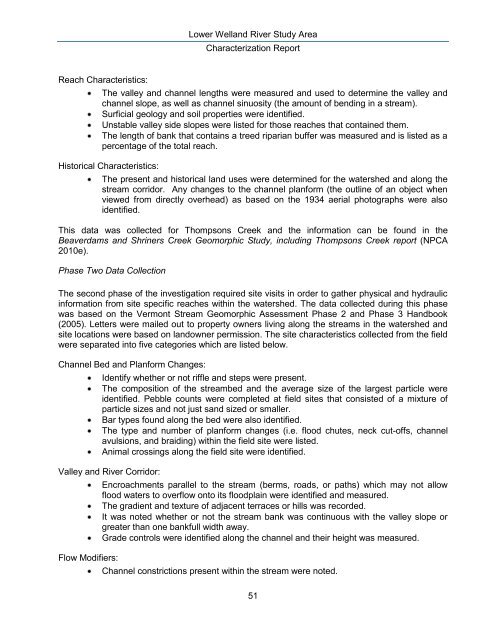Lower Welland River Characterization Report - Niagara Peninsula ...
Lower Welland River Characterization Report - Niagara Peninsula ...
Lower Welland River Characterization Report - Niagara Peninsula ...
You also want an ePaper? Increase the reach of your titles
YUMPU automatically turns print PDFs into web optimized ePapers that Google loves.
<strong>Lower</strong> <strong>Welland</strong> <strong>River</strong> Study Area<br />
<strong>Characterization</strong> <strong>Report</strong><br />
Reach Characteristics:<br />
The valley and channel lengths were measured and used to determine the valley and<br />
channel slope, as well as channel sinuosity (the amount of bending in a stream).<br />
Surficial geology and soil properties were identified.<br />
Unstable valley side slopes were listed for those reaches that contained them.<br />
The length of bank that contains a treed riparian buffer was measured and is listed as a<br />
percentage of the total reach.<br />
Historical Characteristics:<br />
The present and historical land uses were determined for the watershed and along the<br />
stream corridor. Any changes to the channel planform (the outline of an object when<br />
viewed from directly overhead) as based on the 1934 aerial photographs were also<br />
identified.<br />
This data was collected for Thompsons Creek and the information can be found in the<br />
Beaverdams and Shriners Creek Geomorphic Study, including Thompsons Creek report (NPCA<br />
2010e).<br />
Phase Two Data Collection<br />
The second phase of the investigation required site visits in order to gather physical and hydraulic<br />
information from site specific reaches within the watershed. The data collected during this phase<br />
was based on the Vermont Stream Geomorphic Assessment Phase 2 and Phase 3 Handbook<br />
(2005). Letters were mailed out to property owners living along the streams in the watershed and<br />
site locations were based on landowner permission. The site characteristics collected from the field<br />
were separated into five categories which are listed below.<br />
Channel Bed and Planform Changes:<br />
Identify whether or not riffle and steps were present.<br />
The composition of the streambed and the average size of the largest particle were<br />
identified. Pebble counts were completed at field sites that consisted of a mixture of<br />
particle sizes and not just sand sized or smaller.<br />
Bar types found along the bed were also identified.<br />
The type and number of planform changes (i.e. flood chutes, neck cut-offs, channel<br />
avulsions, and braiding) within the field site were listed.<br />
Animal crossings along the field site were identified.<br />
Valley and <strong>River</strong> Corridor:<br />
Flow Modifiers:<br />
Encroachments parallel to the stream (berms, roads, or paths) which may not allow<br />
flood waters to overflow onto its floodplain were identified and measured.<br />
The gradient and texture of adjacent terraces or hills was recorded.<br />
It was noted whether or not the stream bank was continuous with the valley slope or<br />
greater than one bankfull width away.<br />
Grade controls were identified along the channel and their height was measured.<br />
Channel constrictions present within the stream were noted.<br />
51

















